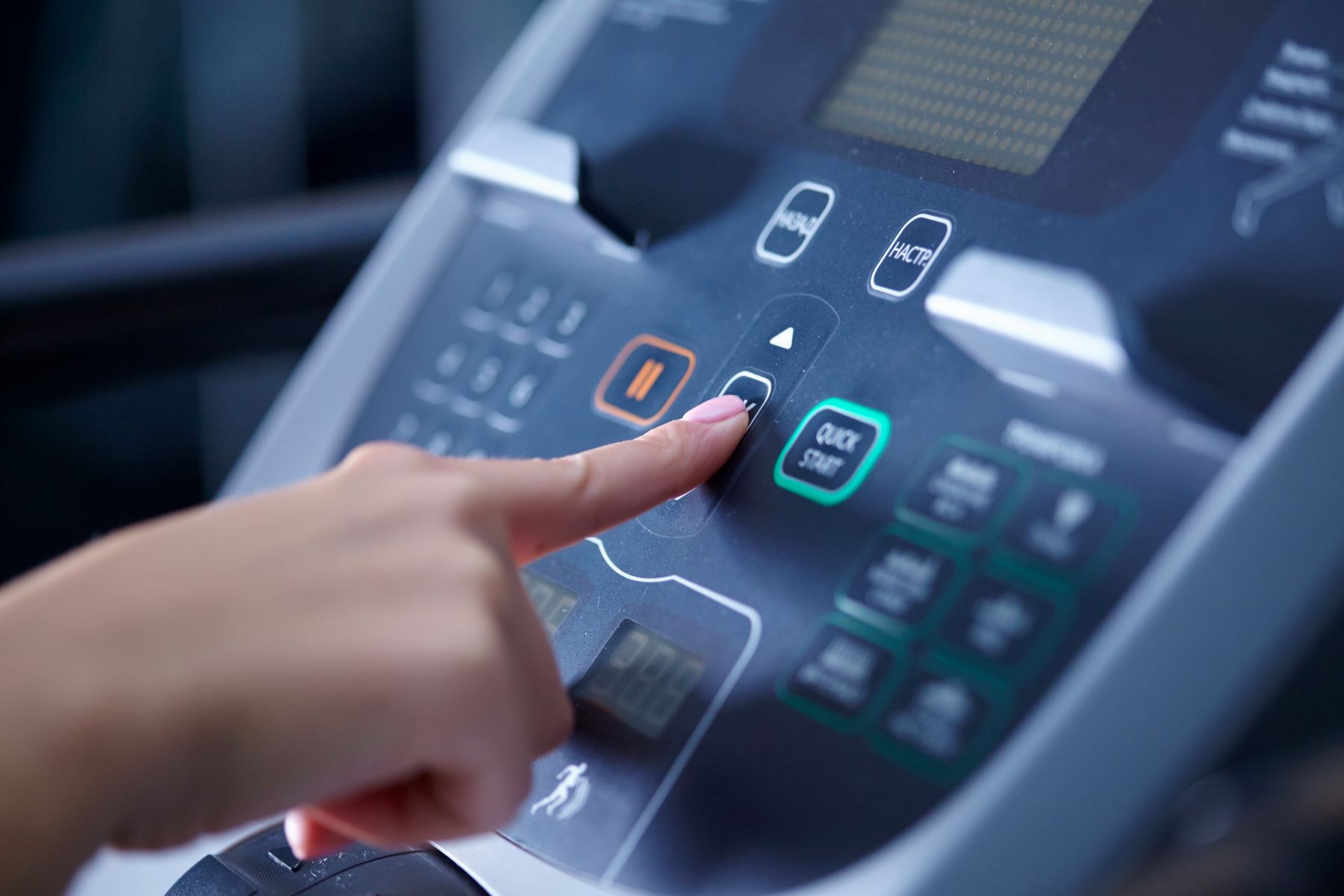Home>Misc>Featured>When You Become Out Of Breath And Your Muscles Begin To Burn During A Workout This Is Caused By


Featured
When You Become Out Of Breath And Your Muscles Begin To Burn During A Workout This Is Caused By
Modified: January 2, 2024
Experience the burn and breathlessness during your workout with Featured, as your muscles push past their limits, delivering optimal results.
Introduction
When you engage in a vigorous workout, it’s not uncommon to experience a feeling of breathlessness and a burning sensation in your muscles. These sensations can occur during various physical activities, such as running, weightlifting, or high-intensity interval training.
This article aims to explore the physiological mechanisms behind these sensations and explain why they occur. Understanding the causes of breathlessness and muscle burn during a workout can help you optimize your training and make informed decisions to improve your performance.
Breathlessness, also known as dyspnea, is the sensation of feeling out of breath or struggling to get enough air into your lungs. It can arise from various factors, including increased demand for oxygen, buildup of carbon dioxide, or changes in lung function during exercise.
Muscle burn, on the other hand, is characterized by a burning sensation in your muscles, often accompanied by fatigue and a temporary decrease in strength. This feeling of burn is commonly associated with activities that require repetitive or sustained muscle contractions.
It’s important to note that experiencing breathlessness and muscle burn during a workout is a normal physiological response. These sensations indicate that your body is working hard and adapting to the demands you’re placing on it.
However, it’s essential to understand the underlying mechanisms that contribute to these sensations to ensure you’re training effectively and safely. Identifying the causes of breathlessness and muscle burn can help you tailor your exercise routine, adjust your intensity level, and optimize your recovery strategies.
In the following sections of this article, we will delve deeper into the physiology of exercise-induced breathlessness and muscle burn, explore the factors contributing to these sensations, and discuss strategies to minimize their occurrence. By gaining a better understanding of these concepts, you’ll be better equipped to enhance your workout performance and achieve your fitness goals.
The Physiology of Exercise-induced Breathlessness
During exercise, your body undergoes several physiological changes to meet the increased demands for energy and oxygen. These changes occur in the respiratory system, cardiovascular system, and musculoskeletal system.
When you engage in physical activity, your muscles require more oxygen to produce energy. In response, your breathing rate and depth increase to deliver oxygen-rich air to your lungs. The increased breathing effort can lead to a feeling of breathlessness.
One of the primary physiological factors contributing to breathlessness during exercise is the increased ventilation-perfusion mismatch. Ventilation refers to the amount of air that reaches your lungs, while perfusion refers to the blood flow to your lungs. During exercise, your breathing rate increases more than your cardiac output, which can lead to inadequate blood flow to the lungs.
Additionally, during high-intensity exercise, the increase in carbon dioxide production exceeds the body’s capacity to eliminate it. Carbon dioxide accumulates in your muscles and bloodstream, stimulating your respiratory drive and causing a sensation of breathlessness. This buildup of carbon dioxide can also lead to a decrease in blood pH, contributing to the feeling of breathlessness.
Another factor contributing to exercise-induced breathlessness is the activation of the sympathetic nervous system. The sympathetic nervous system controls the fight-or-flight response and increases heart rate and cardiac output during exercise. This increased activation can result in a heightened perception of breathlessness.
Lastly, breathlessness can be influenced by psychophysiological factors, such as anxiety or stress. These factors can contribute to a heightened perception of effort and breathlessness during exercise, even if the physiological demands are not significantly higher.
Overall, exercise-induced breathlessness is a complex interplay between physiological changes in ventilation, carbon dioxide buildup, sympathetic nervous system activation, and psychophysiological factors. Understanding these mechanisms can help you manage your breathlessness during workouts and adapt your training strategies accordingly.
Factors Contributing to Breathlessness
Exercise-induced breathlessness can be influenced by several factors, both physiological and non-physiological. Understanding these factors can help you identify the root causes of breathlessness and make necessary adjustments to your workout routine. Let’s explore some of the key factors that contribute to breathlessness during exercise.
1. Fitness Level: Your fitness level plays a significant role in determining your breathlessness during physical activity. Individuals with lower aerobic fitness levels may experience breathlessness more quickly and intensely compared to those with higher fitness levels. Regular cardiovascular exercise can improve your fitness level, making it easier for your body to meet the increased oxygen demands during exercise and reducing the sensation of breathlessness.
2. Exercise Intensity: The intensity at which you exercise directly affects your breathlessness. Higher-intensity activities, such as sprinting or high-intensity interval training, can result in a rapid increase in breathing rate and depth, leading to a more pronounced sensation of breathlessness. Lower-intensity activities, on the other hand, may not elicit the same level of breathlessness.
3. Duration of Exercise: The duration of your workout can also contribute to breathlessness. Prolonged exercise sessions can accumulate oxygen debt, causing a feeling of breathlessness as your body tries to catch up with the increased demand for oxygen. Shorter, more intense workouts may induce breathlessness more quickly, while longer, steady-state exercises may result in a gradual onset of breathlessness.
4. Environmental Conditions: The environment in which you exercise can impact your breathing and contribute to breathlessness. High temperatures, humidity, or poor air quality can make it more challenging for your respiratory system to meet the oxygen demands, leading to increased breathlessness. Ensuring proper hydration and choosing suitable exercise environments can help minimize these effects.
5. Underlying Health Conditions: Certain underlying health conditions, such as asthma or chronic obstructive pulmonary disease (COPD), can make you more susceptible to breathlessness during exercise. It’s essential to consult with a healthcare professional if you experience severe or persistent breathlessness to rule out any underlying medical conditions.
6. Psychological Factors: Psychological factors, such as anxiety or stress, can contribute to a sensation of breathlessness during exercise. These non-physiological factors can increase the perception of effort and exacerbate breathlessness. Incorporating stress management techniques, such as deep breathing exercises or mindfulness, can help alleviate the psychological burden and reduce breathlessness.
By considering these factors and adjusting your exercise regimen accordingly, you can optimize your workout experience and manage breathlessness effectively. Gradual increases in intensity, focusing on proper breathing techniques, and training at a level suitable for your fitness abilities can help mitigate the sensation of breathlessness during exercise.
Understanding Muscle Burn During Workouts
One of the common sensations experienced during intense exercise is the burning sensation in your muscles. This sensation, often referred to as muscle burn, is a result of various physiological processes occurring within your muscles during workouts. Understanding the mechanisms behind muscle burn can help you optimize your training and push through discomfort.
Muscle burn is primarily caused by the accumulation of metabolic byproducts within the muscle tissues during exercise. As you engage in physical activity, your muscles require energy to contract and generate force. This energy is produced through the breakdown of stored carbohydrates and the subsequent production of adenosine triphosphate (ATP).
During high-intensity exercises, such as weightlifting or sprinting, your muscles rely heavily on anaerobic metabolism, which does not require oxygen. This anaerobic metabolism leads to the production of lactic acid as a byproduct. As lactic acid builds up in the muscle tissues, it lowers the pH level, causing a burning sensation in the muscles.
Furthermore, the accumulation of lactic acid also disrupts the balance of ions within the muscle cells. This disruption affects the muscle’s ability to contract and can contribute to muscle fatigue and a decrease in performance. It’s important to note that muscle burn is a temporary sensation and usually subsides shortly after the exercise session ends.
Muscle burn can also occur during activities that involve sustained muscle contractions or a prolonged time under tension, such as isometric holds or slow eccentric movements. These exercises can lead to the buildup of metabolic waste products and a delay in blood flow to the muscles, resulting in a prolonged muscle burn sensation.
While muscle burn can be uncomfortable, it is not necessarily an indicator of muscle growth or a more effective workout. The burning sensation is primarily related to the energy systems being utilized and the accumulation of lactate, rather than to the actual muscle damage or growth process. It’s important to differentiate between muscle burn and muscle fatigue, as excessive muscle fatigue can increase the risk of injury.
To minimize muscle burn during workouts, it’s essential to gradually increase the intensity and duration of your exercises, allowing your muscles time to adapt. Additionally, maintaining proper hydration, breathing techniques, and incorporating adequate rest and recovery periods can help reduce the severity of muscle burn.
Understanding the mechanisms of muscle burn can empower you to push through uncomfortable sensations and train more effectively. By utilizing proper training techniques, managing your intensity levels, and listening to your body, you can optimize your workouts and achieve your fitness goals while minimizing the discomfort of muscle burn.
Causes of Muscle Burn During Exercise
The sensation of muscle burn during exercise is a result of several factors that contribute to metabolic stress within the muscle tissues. Understanding these causes can help you better manage and alleviate muscle burn, allowing you to optimize your workouts and enhance your performance.
1. Lactic Acid Accumulation: One of the primary causes of muscle burn is the accumulation of lactic acid. During high-intensity exercise, your muscles rely on anaerobic metabolism, which produces lactic acid as a byproduct. The buildup of lactic acid contributes to a decrease in muscle pH, leading to the burning sensation. The duration and intensity of the exercise, as well as your individual lactate tolerance, can affect the extent of lactic acid accumulation and muscle burn.
2. Increased Metabolic Waste Products: Alongside lactic acid, other metabolic waste products, such as hydrogen ions, contribute to muscle burn. These waste products disrupt the muscle’s pH balance and interfere with muscle contraction and function. The accumulation of these waste products occurs as a result of the breakdown of energy sources within the muscles during exercise.
3. Inadequate Blood Flow: During exercise, the demands for oxygen and nutrients in the muscles increase. However, inadequate blood flow can limit the delivery of these essential components, leading to a decrease in energy production and the accumulation of waste products. This compromised blood flow can result from factors such as intense muscle contractions, posture, and blood vessel constriction.
4. Overload and Fatigue: Engaging in exercises that involve repeated muscle contractions or prolonged time under tension can lead to muscle overload and fatigue. The continuous contraction of muscles causes a reduction in oxygen supply, impairing energy production and leading to the build-up of metabolic waste products. This overload and fatigue contribute to the burning sensation in the muscles during exercise.
5. Increased Muscle Temperature: During exercise, your muscles generate heat, leading to an increase in muscle temperature. This rise in temperature can stimulate nerve endings and contribute to the sensation of muscle burn. Additionally, an increase in muscle temperature can affect muscle performance and increase the production of metabolic waste products.
Understanding the causes of muscle burn can help you develop strategies to alleviate and manage the sensation. Gradually increasing exercise intensity, optimizing blood flow through proper warm-up and stretching, and incorporating techniques such as active recovery can help minimize muscle burn. Additionally, ensuring proper hydration and nutrition can support muscle function and reduce the accumulation of metabolic waste products.
It’s worth noting that muscle burn during exercise is a natural and temporary phenomenon, and it can be an indication that you are challenging your muscles effectively. However, if you experience severe or persistent muscle pain, it is important to consult a healthcare professional to rule out any potential injuries or underlying conditions.
Lactic Acid Accumulation and Muscle Burn
Lactic acid accumulation is a significant contributor to the sensation of muscle burn during exercise. Understanding the role of lactic acid in muscle burn can provide valuable insights into how to manage and optimize your workout experience.
During high-intensity exercises, such as weightlifting or sprinting, your muscles require energy at a faster rate than can be supplied by oxygen alone. This energy demand triggers the breakdown of glucose through a process called glycolysis, leading to the production of ATP. However, when glycolysis occurs without sufficient oxygen supply, it results in the production of lactic acid as a byproduct.
As lactic acid accumulates within the muscle tissues, it dissociates into lactate and hydrogen ions. The increase in hydrogen ions contributes to a decrease in muscle pH, leading to the acidic environment responsible for the burning sensation associated with muscle burn.
Contrary to popular belief, lactic acid itself is not the direct cause of muscle burn. The burning sensation is mainly attributed to the increase in hydrogen ions. The higher the concentration of hydrogen ions, the lower the pH of the muscle, and the more intense the feeling of muscle burn.
Lactic acid accumulation and subsequent muscle burn are influenced by various factors, including exercise intensity, exercise duration, and individual lactate threshold. As exercise intensity increases, the pace of glycolysis also increases, resulting in greater lactic acid production. Prolonged exercise sessions can also contribute to lactic acid accumulation as the body’s capacity to remove lactate is overwhelmed.
It is important to note that lactic acid accumulation and muscle burn are not necessarily negative or detrimental to your workout. In fact, they can be indicators of pushing your body beyond its comfort zone and engaging in intense physical activity. However, excessive muscle burn and acidosis can lead to muscle fatigue and a decrease in exercise performance.
To manage lactic acid accumulation and muscle burn, you can incorporate several strategies into your workout routine. Gradually increasing exercise intensity and duration can allow your body to adapt to the increased demand for energy and improve your lactate threshold. Additionally, proper warm-up exercises, such as dynamic stretching and light aerobic activities, can help prepare your muscles and optimize blood flow, reducing the build-up of lactic acid.
Furthermore, maintaining proper breathing techniques can enhance oxygen delivery during exercise and aid in lactic acid clearance. Focus on deep inhalations and exhalations, allowing for optimal exchange of oxygen and carbon dioxide in the lungs. Proper hydration and nutrition also play a crucial role in supporting muscle function, reducing the accumulation of lactic acid, and promoting recovery.
By understanding the relationship between lactic acid accumulation and muscle burn, you can optimize your workout experience and make informed decisions to push through discomfort while minimizing the risk of muscle fatigue and performance decline.
The Role of Oxygen Debt in Exercise-induced Breathlessness and Muscle Burn
Oxygen debt, also known as excess post-exercise oxygen consumption (EPOC), is a phenomenon that plays a significant role in exercise-induced breathlessness and muscle burn. Understanding the concept of oxygen debt can provide insights into the mechanisms behind these sensations and how to optimize your workouts.
During exercise, your muscles require a constant supply of oxygen to produce energy. As you engage in high-intensity activities, such as sprinting or weightlifting, your body resorts to anaerobic metabolism to meet the energy demands. Anaerobic metabolism relies on stored energy sources, such as glycogen, without the need for oxygen.
However, this anaerobic metabolism comes at a cost. As the intensity of exercise increases, the demand for energy surpasses the body’s ability to deliver oxygen to the muscles. As a result, the oxygen debt accumulates, meaning your body borrows oxygen from other body systems to replenish the oxygen deficit created during intense exercise.
The oxygen debt creates a cascade of physiological events that contribute to exercise-induced breathlessness and muscle burn. First, the body continues to metabolize accumulated lactic acid, converting it back into glycogen and breaking it down with the aid of oxygen. This process is known as lactate clearance and helps reduce the acidic environment in the muscles, alleviating the burning sensation.
Additionally, as the body replenishes oxygen, it restores ATP and phosphocreatine levels, which are essential energy sources for muscle contractions. The reestablishment of adequate energy stores enables your muscles to maintain optimal function and may reduce the perception of fatigue and breathlessness.
Moreover, the repayment of oxygen debt requires the continued elevation of oxygen consumption even after exercise. This increased oxygen consumption increases the body’s metabolic rate, leading to a higher caloric burn during the post-exercise period. This is one of the reasons why high-intensity workouts are often favored for fat loss and improving cardiovascular fitness.
To maximize the benefits of oxygen debt and mitigate the sensations of breathlessness and muscle burn, incorporating proper recovery strategies is crucial. Cool-down exercises, such as light aerobic activities or stretching, help gradually bring your body back to a resting state and facilitate the clearance of metabolic waste products.
Additionally, adequate hydration, proper nutrition, and sufficient rest are essential for optimizing recovery and minimizing the impact of oxygen debt. These practices support the body’s ability to replenish energy stores and promote muscle repair and growth.
Understanding the role of oxygen debt in exercise-induced breathlessness and muscle burn can help you tailor your workout routine and recovery strategies to maximize performance and minimize discomfort. By acknowledging the importance of oxygen debt and the physiological processes involved, you can make informed decisions to optimize your training outcomes.
Strategies to Reduce Breathlessness and Muscle Burn During Workouts
Experiencing breathlessness and muscle burn during workouts is a natural response to intense physical activity. However, there are strategies you can employ to minimize these sensations and optimize your training sessions. By incorporating the following strategies, you can improve your overall workout experience and performance.
1. Gradual Progression: Gradually increase the intensity and duration of your workouts over time. This approach allows your body to adapt and build tolerance to higher levels of exertion, minimizing the onset of breathlessness and muscle burn. Avoid sudden spikes in intensity or overly ambitious workout routines that may lead to excessive fatigue or discomfort.
2. Proper Breathing Techniques: Focus on maintaining proper breathing techniques during your workouts. Deep diaphragmatic breathing helps deliver sufficient oxygen to your muscles and aids in minimizing breathlessness. Inhale deeply through your nose and exhale fully through your mouth, ensuring a steady flow of oxygen during exercise.
3. Interval Training: Incorporate interval training into your routine. This involves alternating periods of high-intensity exercise with lower-intensity recovery periods. Interval training can improve your cardiovascular fitness and increase your lactate threshold, allowing you to delay the onset of breathlessness and muscle burn during high-intensity workouts.
4. Focus on Form and Technique: Pay attention to your form and technique during exercises. Proper form ensures that you are efficiently using your muscles, minimizing unnecessary strain and fatigue. This allows you to maintain control and conserve energy during your workouts, reducing the likelihood of early onset breathlessness and muscle burn.
5. Hydration and Nutrition: Stay properly hydrated before, during, and after your workouts. Dehydration can exacerbate the sensations of breathlessness and muscle burn. Additionally, make sure to fuel your body with balanced nutrition, providing the necessary energy and nutrients to support your workouts and aid in recovery.
6. Adequate Rest and Recovery: Allow your body enough time to recover between workouts. Rest and recovery are crucial for muscle repair and adaptation, which can help reduce the occurrence of muscle burn and breathlessness. Incorporate rest days into your training schedule and prioritize recovery activities, such as stretching, foam rolling, and getting enough sleep.
7. Incorporate Cross-training: Engage in a variety of exercises and training modalities to reduce the repetitive strain on specific muscle groups. Cross-training helps distribute the workload among different muscles, reducing the likelihood of early muscle fatigue, burn, and breathlessness. It also enhances overall fitness and prevents overuse injuries.
8. Mental Strategies: Utilize mental strategies to help manage breathlessness and muscle burn. Techniques such as visualization, positive self-talk, and mindfulness can help shift your focus away from discomfort and enhance your ability to push through challenging moments during your workouts.
By implementing these strategies, you can reduce breathlessness and muscle burn during your workouts, allowing you to perform at your best while minimizing discomfort. Remember to listen to your body, honor your limits, and make adjustments as needed to optimize your training experience.
Conclusion
Experiencing breathlessness and muscle burn during workouts is a common occurrence, especially during high-intensity exercises. These sensations are a natural response to the physiological demands of physical activity and can be influenced by various factors such as exercise intensity, duration, and personal fitness level.
Understanding the physiology behind exercise-induced breathlessness and muscle burn can help you optimize your workouts and manage these sensations effectively. Lactic acid accumulation, oxygen debt, and other factors contribute to the burning sensation in your muscles and the feeling of breathlessness.
By employing strategies such as gradual progression, proper breathing techniques, interval training, and focusing on form and technique, you can reduce the onset and severity of breathlessness and muscle burn. Additionally, prioritizing hydration, nutrition, rest, and recovery supports your body’s ability to perform optimally and minimize discomfort.
It’s important to remember that while these sensations may be uncomfortable, they are part of the normal physiological response to exercise. However, if you experience severe or persistent pain or breathlessness, it is essential to consult a healthcare professional to rule out any underlying medical conditions or injuries.
Incorporate the strategies outlined in this article into your exercise routine and tailor them to your individual needs and fitness goals. By doing so, you can optimize your workout experience, enhance your performance, and continue progressing towards your fitness objectives.
Embrace the challenge of breathlessness and muscle burn as signs of your body adapting and growing stronger. With dedication, proper training techniques, and a mindset focused on progress, you can push through these discomforts and achieve your fitness aspirations. Remember to listen to your body, prioritize self-care, and enjoy the journey towards a stronger, healthier you.









